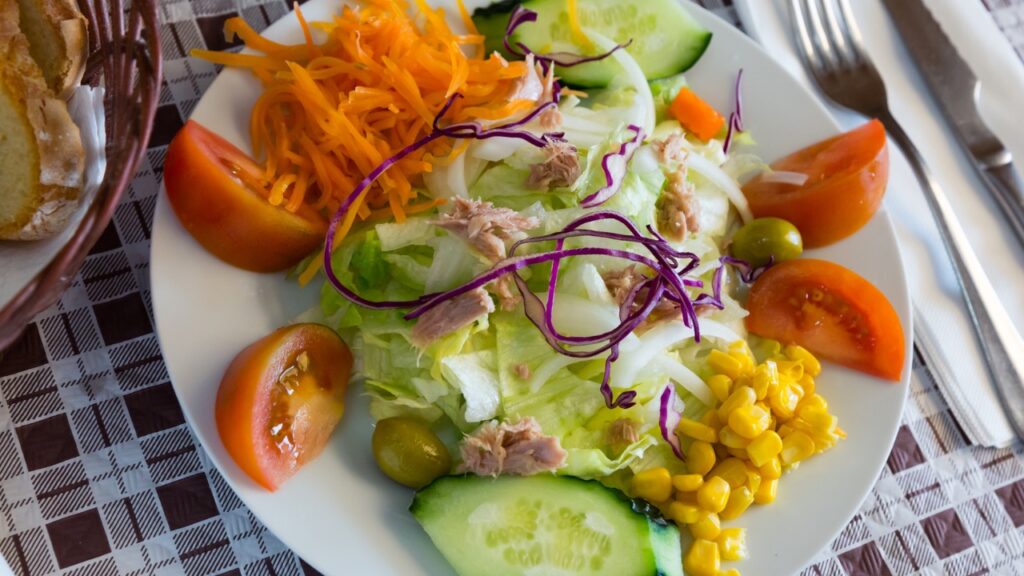Mastering Low Calorie Food Pairing Rules for Effective Dieting
Table of Contents
The importance of low-calorie food pairing in effective dieting
In the world of dieting, finding the right combination of foods can make all the difference in achieving your weight loss goals. Low-calorie food pairing is a strategy that has gained significant attention for its ability to enhance the effectiveness of a diet. By carefully selecting and combining foods with low calorie counts, you can create meals that are not only satisfying and nutritious but also support your weight loss efforts.
When it comes to weight loss, the basic principle is simple: consume fewer calories than you burn. However, it’s not always easy to determine which foods will provide the greatest nutritional value while keeping calorie intake in check. This is where the concept of low-calorie food pairing comes into play.
By understanding the science behind food pairing, you can optimize your diet to support weight loss and overall health. Food pairing refers to the practice of combining certain foods together to maximize their nutritional benefits and promote efficient digestion. When it comes to low-calorie food pairing, the focus is on selecting foods that are low in calories but high in essential nutrients like vitamins, minerals, and fiber.
The benefits of low-calorie food pairing are numerous. Not only does it help to create a well-rounded and balanced diet, but it also ensures that you are getting the most out of every calorie consumed. By combining proteins and vegetables, incorporating fiber-rich foods, and balancing carbohydrates and proteins, you can create meals that are both satisfying and calorie-conscious. Additionally, by limiting fats and sugars and utilizing herbs and spices for flavor, you can enhance the taste of your meals without adding unnecessary calories.
In this article, we will explore the low-calorie food pairing rules that can help you master the art of effective dieting. We will also provide you with a variety of sample low-calorie food pairing recipes to inspire your culinary adventures. Furthermore, we will share some tips for success to ensure that you stay on track with your weight loss journey.
So, if you’re ready to discover the power of low-calorie food pairing and take your dieting efforts to the next level, let’s dive in and explore the world of nutritious and delicious food combinations that will support your weight loss goals.
Understanding Low-Calorie Food Pairing
In the pursuit of effective dieting, understanding the concept of low-calorie food pairing is crucial. By combining and consuming certain foods together, individuals can enhance their weight loss efforts and achieve their health goals more efficiently.
What is food pairing?
Food pairing refers to the practice of combining specific foods that work synergistically to create a balanced and satisfying meal. It involves selecting ingredients that complement each other in taste, texture, and nutritional value. By strategically pairing foods, individuals can optimize their nutrient intake while minimizing their calorie consumption.
Benefits of low-calorie food pairing
Embracing low-calorie food pairing offers a myriad of benefits that go beyond weight loss. Firstly, it allows individuals to enjoy a wider variety of flavors and textures in their meals, making the dieting journey more enjoyable and sustainable. The combination of different ingredients also ensures a well-rounded nutrient profile, supplying the body with essential vitamins, minerals, and antioxidants.
Moreover, low-calorie food pairing promotes satiety and helps control hunger. By incorporating proteins, fibers, and complex carbohydrates into meals, individuals can feel fuller for longer periods, reducing the urge to snack on unhealthy, calorie-dense foods.
How it aids in weight loss
Low-calorie food pairing aids in weight loss by promoting a calorie deficit while still providing the necessary nutrients for optimal health. By combining proteins and vegetables, one can create satisfying and nutritious meals that are low in calories. Proteins take longer to digest, requiring more energy, which can boost metabolism and support fat burning.
Incorporating fiber-rich foods into the diet also aids in weight loss. Fiber adds bulk to meals, promoting a feeling of fullness and reducing overeating. Additionally, fiber aids in digestion and regulates blood sugar levels, preventing spikes and crashes that can lead to cravings and overconsumption of calories.
By balancing carbohydrates and proteins, individuals can maintain stable energy levels throughout the day, preventing sudden drops in blood sugar that can trigger cravings for unhealthy, high-calorie foods. Limiting fats and sugars further helps reduce calorie intake and supports weight loss efforts.
Finally, utilizing herbs and spices for flavor enhances the taste of low-calorie meals without adding excessive calories. These flavorful additions can make healthy eating more enjoyable and satisfying, reducing the desire for calorie-laden condiments and sauces.
Understanding the principles of low-calorie food pairing and implementing them into your diet can revolutionize your weight loss journey. By incorporating the right combinations of foods, you can create delicious, satisfying meals that are both nutritious and conducive to your health goals.
Continue reading to discover low-calorie food pairing rules that will help you make the most of your dieting efforts.
low calorie food pairing guide
Low-Calorie Food Pairing Rules
When it comes to effective dieting, low-calorie food pairing plays a crucial role in achieving your goals. By understanding and implementing the right food pairing strategies, you can optimize your meals for both nutrition and weight loss. In this section, we will explore some essential low-calorie food pairing rules that will help you make informed choices and create delicious, satisfying meals.
Combining Proteins and Vegetables
One of the fundamental rules of low-calorie food pairing is to combine proteins and vegetables in your meals. Proteins are essential for building and repairing tissues, while vegetables provide valuable vitamins, minerals, and fiber. When you pair these two food groups, you create a balanced meal that keeps you feeling full and satisfied for longer periods.
For example, instead of having a plain chicken breast, consider adding a generous portion of steamed broccoli or a colorful salad to your plate. The proteins in the chicken will provide satiety, while the vegetables add volume and valuable nutrients to your meal. This combination not only enhances the flavor and texture of your dish but also ensures you’re getting a well-rounded nutritional profile.
Incorporating Fiber-Rich Foods
Another key element in low-calorie food pairing is incorporating fiber-rich foods into your diet. Fiber not only aids in digestion but also helps control blood sugar levels and promotes a feeling of fullness. By including foods such as whole grains, legumes, fruits, and vegetables, you can increase your fiber intake and create a more satisfying meal.
For instance, instead of opting for refined carbohydrates like white bread or pasta, choose whole grain options like quinoa or whole wheat bread. Pair these fiber-rich choices with a variety of colorful vegetables to create a nutrient-dense and filling meal. By doing so, you can enjoy the benefits of increased fiber intake while keeping your calorie count in check.
Balancing Carbohydrates and Proteins
Balancing carbohydrates and proteins is an essential aspect of low-calorie food pairing. While carbohydrates provide energy, proteins aid in muscle repair and growth. By combining these two macronutrients in your meals, you can create a balanced plate that promotes satiety and supports your weight loss goals.
For example, if you’re having a bowl of pasta, consider adding lean protein sources such as grilled chicken or shrimp. This combination not only adds flavor and texture to your dish but also ensures that you’re getting a good balance of nutrients. By incorporating both carbohydrates and proteins in your meals, you can maintain steady energy levels and avoid unnecessary snacking.
Limiting Fats and Sugars
When it comes to low-calorie food pairing, it’s important to be mindful of your fat and sugar intake. While healthy fats are essential for overall health, consuming them in excess can lead to weight gain. Similarly, added sugars can contribute to empty calories and hinder your weight loss efforts.
Instead of relying on high-fat dressings or sugary sauces, opt for healthier alternatives such as olive oil, vinegar, or lemon juice for dressings, and herbs and spices for flavor. By limiting the amount of fats and sugars in your meals, you can create flavorful dishes without compromising on your calorie goals.
Utilizing Herbs and Spices for Flavor
Last but not least, one of the low-calorie food pairing secrets lies in utilizing herbs and spices for flavor. By incorporating a variety of herbs and spices in your meals, you can enhance the taste of your dishes without adding excessive calories. Additionally, many herbs and spices have medicinal properties and can provide various health benefits.
Experiment with different combinations of herbs and spices to create exciting and flavorful meals. For example, try adding a pinch of turmeric and cumin to your roasted vegetables or sprinkle some fresh basil and oregano over your grilled chicken. These small additions can elevate the taste of your dishes and make your meals more enjoyable.
By following these low-calorie food pairing rules, you can create well-balanced, satisfying meals that support your weight loss journey. Remember to incorporate a variety of proteins, vegetables, fiber-rich foods, and herbs and spices into your diet to maximize both nutrition and flavor. With these guidelines, you’ll be well on your way to achieving your health and wellness goals.
For more inspiration and ideas on low-calorie food pairings, check out our low calorie food pairing ideas for a wide range of delicious recipes and combinations.
Sample Low-Calorie Food Pairing Recipes
Breakfast options
Start your day off right with these delicious and satisfying low-calorie breakfast options. These recipes are designed to fuel your body and keep you feeling full until lunchtime.
-
Egg and vegetable scramble: Whip up a tasty combination of scrambled eggs and sautéed vegetables such as bell peppers, spinach, and mushrooms. This protein-packed breakfast will keep you energized throughout the morning.
-
Greek yogurt with berries and nuts: Enjoy a bowl of creamy Greek yogurt topped with a handful of fresh berries and a sprinkle of chopped nuts. This simple and nutritious breakfast is packed with protein, fiber, and antioxidants.
-
Oatmeal with banana and almond butter: Cook a serving of oatmeal and top it with sliced bananas and a drizzle of almond butter. This hearty breakfast is not only low in calories but also provides a good source of complex carbohydrates and healthy fats.
Lunch ideas
When it comes to lunch, it’s important to choose options that are both satisfying and low in calories. These lunch ideas are packed with flavor and nutrients to keep you going throughout the day.
-
Grilled chicken salad: Toss together a bed of mixed greens, grilled chicken breast, cherry tomatoes, cucumber slices, and a light vinaigrette dressing. This refreshing salad is a perfect balance of protein, vegetables, and healthy fats.
-
Vegetable stir-fry with tofu: Sauté a colorful array of vegetables such as broccoli, bell peppers, snap peas, and carrots, and add tofu for a protein boost. Season with soy sauce and spices for a flavorful and filling lunch option.
-
Quinoa and black bean bowl: Cook quinoa and mix it with black beans, diced tomatoes, corn, avocado, and a squeeze of lime juice. This nutritious and satisfying bowl is rich in fiber, protein, and essential vitamins and minerals.
Dinner recipes
For dinner, you can enjoy a variety of flavorful and low-calorie meals. These recipes are designed to be both nutritious and delicious, making it easier to stick to your diet.
-
Baked salmon with roasted vegetables: Season a fillet of salmon with herbs and spices, and bake it in the oven. Serve it with a side of roasted vegetables such as asparagus, zucchini, and cherry tomatoes. This meal is packed with omega-3 fatty acids, protein, and fiber.
-
Turkey lettuce wraps: Cook ground turkey with a mix of aromatic vegetables and spices, and serve it in lettuce wraps. Top with a drizzle of low-calorie sauce for added flavor. These wraps are low in carbs and high in protein, making them a healthy and satisfying dinner option.
-
Zucchini noodles with marinara sauce: Spiralize zucchini into noodles and sauté them until tender. Top with a homemade marinara sauce and sprinkle with grated Parmesan cheese. This low-calorie alternative to traditional pasta is a great way to incorporate more vegetables into your diet.
Snack suggestions
When cravings strike between meals, reach for these low-calorie snack options to satisfy your hunger without derailing your diet.
-
Apple slices with peanut butter: Slice up an apple and enjoy it with a tablespoon of peanut butter. This snack provides a satisfying crunch, natural sweetness, and a combination of protein and healthy fats.
-
Celery sticks with hummus: Dip celery sticks into a serving of hummus for a crunchy and nutritious snack. Celery is hydrating and low in calories, while hummus provides protein and fiber.
-
Greek yogurt with a sprinkle of granola: Enjoy a small cup of Greek yogurt with a sprinkle of granola for added texture and flavor. This snack is a great source of protein and calcium, and the granola adds a satisfying crunch.
With these sample low-calorie food pairing recipes, you can enjoy delicious and nutritious meals while sticking to your weight loss goals. Remember to experiment with different flavor combinations and get creative in the kitchen. Happy cooking!
Tips for Success
When it comes to achieving success in your low-calorie food pairing journey, there are several key tips to keep in mind. By following these guidelines, you can optimize your dieting efforts and make the most out of your weight loss goals.
Meal Planning and Preparation
One of the most effective strategies for success in low-calorie food pairing is proper meal planning and preparation. By taking the time to plan out your meals in advance, you can ensure that you have a variety of healthy options readily available. This way, you can avoid making impulsive food choices that may derail your progress.
Consider creating a weekly meal plan that includes a balance of proteins, vegetables, and other essential nutrients. This not only helps you stay on track but also saves you time and energy throughout the week. By having a clear vision of what you will be eating, you can easily make a shopping list and stock your kitchen with the necessary ingredients.
Portion Control
Another crucial aspect of successful low-calorie food pairing is portion control. While it’s important to choose healthy and nutrient-rich foods, consuming them in excessive quantities can still hinder your weight loss efforts. Paying attention to portion sizes can make a significant difference in your calorie intake.
To practice portion control, consider using smaller plates and bowls to create the illusion of a fuller plate. Additionally, take your time while eating and listen to your body’s hunger and fullness cues. This will help you avoid overeating and promote mindful eating habits.
Staying Hydrated
Staying properly hydrated is essential for overall health and is particularly important when following a low-calorie diet. Staying hydrated can help curb cravings, promote digestion, and support your body’s natural detoxification processes.
Make sure to drink plenty of water throughout the day. You can also incorporate herbal teas or infused water for added flavor and variety. Avoid sugary beverages and opt for healthier alternatives like unsweetened tea or sparkling water.
Tracking Progress
Lastly, tracking your progress is a vital component of achieving success in your low-calorie food pairing journey. By keeping a record of your meals, calorie intake, and even your emotions surrounding food, you can gain valuable insights into your eating habits and make necessary adjustments.
There are various ways to track your progress, such as using a food journal or a mobile app specifically designed for this purpose. This allows you to monitor your calorie intake, track your weight loss, and identify any patterns or areas for improvement.
Remember, success in low-calorie food pairing is a journey, and everyone’s progress will be unique. By implementing these tips and staying dedicated to your goals, you can make positive changes to your diet and achieve the results you desire.
Click here to learn more about low calorie food pairing tips.
Conclusion
In conclusion, mastering low-calorie food pairing is a powerful tool for effective dieting. By understanding the principles of food pairing and incorporating them into your meals, you can take control of your weight loss journey and achieve your goals more efficiently.
Throughout this article, we have explored the importance of low-calorie food pairing in effective dieting. We have learned that food pairing involves combining different types of foods to create balanced meals that are satisfying and nutritious. By following low-calorie food pairing rules, such as combining proteins and vegetables, incorporating fiber-rich foods, balancing carbohydrates and proteins, limiting fats and sugars, and utilizing herbs and spices for flavor, you can create meals that are not only low in calories but also delicious and satisfying.
Moreover, we have provided sample low-calorie food pairing recipes for breakfast, lunch, dinner, and snacks, giving you practical ideas to get started on your journey. These recipes showcase the versatility and variety of low-calorie food pairing options available to you.
To ensure success with low-calorie food pairing, we have shared valuable tips, including the importance of meal planning and preparation, portion control, staying hydrated, and tracking your progress. These strategies will help you stay on track and maintain a balanced approach to your diet.
By incorporating low-calorie food pairing into your lifestyle, you can discover a whole new world of delicious and healthy meals that will support your weight loss goals. Remember to visit Good Food Mama for more low calorie meal pairings, food pairing ideas, and recipes to inspire your culinary journey.
So, why wait? Start exploring the world of low-calorie food pairing today and transform your diet into a vibrant and nourishing experience. With dedication and creativity, you can achieve a healthier and happier you.







